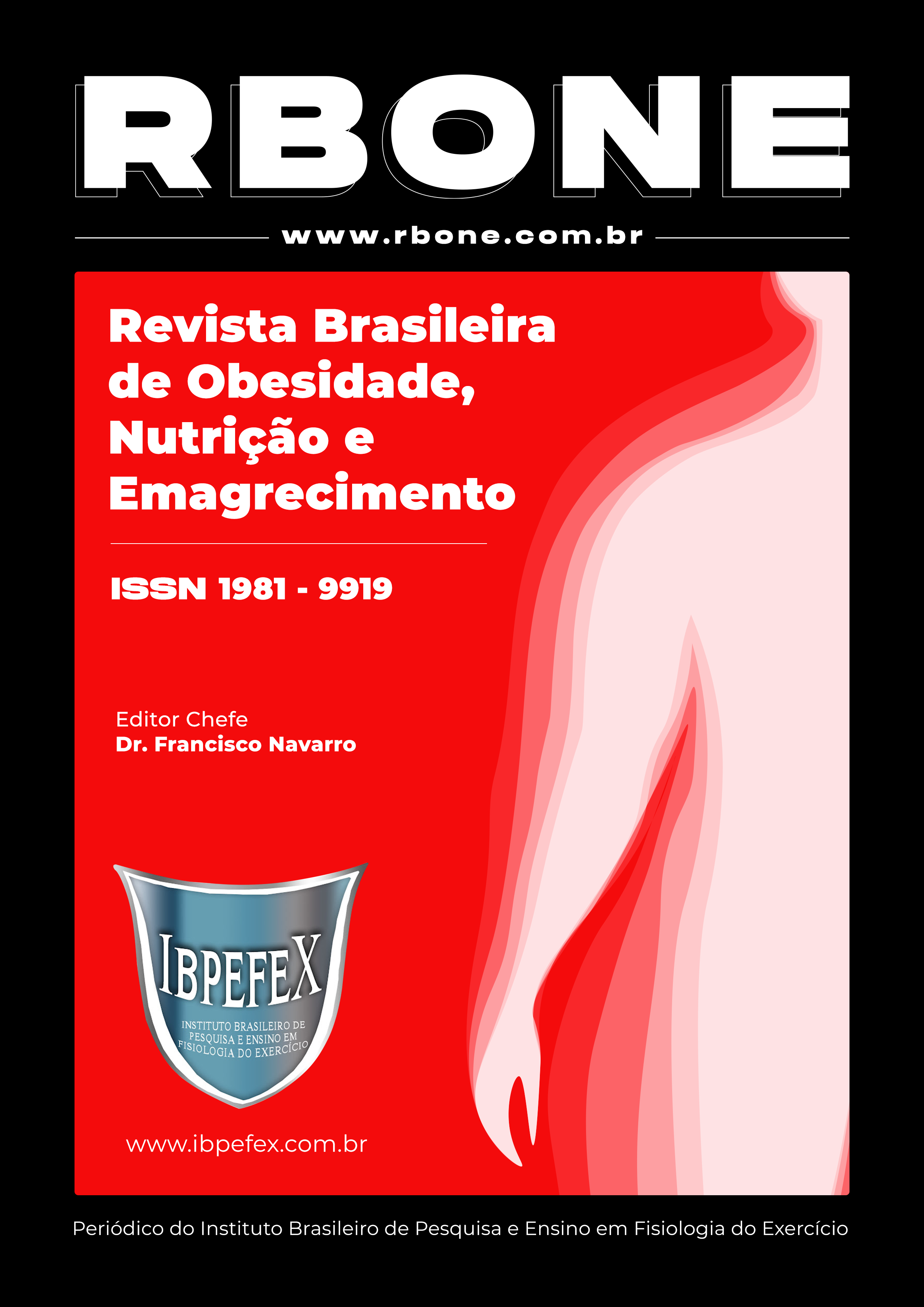THE The role of passive displacement in the prevalence of body fat in adolescents
Abstract
In recent decades, we have observed a decline in active commuting to school and a concerning increase in obesity among adolescents. This study involved 2,694 adolescents from Porto Velho, Brazil, with 40.7% attending private schools and 59.3% attending public schools. Commuting to school was assessed through a questionnaire, with measurements of weight and height collected to calculate the Body Mass Index (BMI) and tricipital and subscapular skinfold thickness used to estimate the percentage of body fat (%BF). Binary logistic regression was employed for statistical analysis to identify associations between excess weight, %BF, and commuting modes (active or passive). The prevalence of excess weight was more prominent among those who opted for passive commuting (82.7%), especially among females (83.8%), and those with excess %BF (81.3%, females: 83.3%). After adjustments, excess weight remained significantly associated with passive commuting (24.6%, OR=1.37; 95% CI: 1.07-1.78), with a higher risk among females (22.6%, OR=1.91; 95% CI: 1.07-2.77) and those with high %BF (64.1%, OR=2.05; 95% CI: 1.17-3.00, females: 69.2%, OR=1.98; 95% CI: 1.08-2.88). Therefore, it is urgent to implement public policies that promote active commuting to school among adolescents as a measure to curb the growth of excess weight and %BF. These actions can have a positive impact on the health and well-being of adolescents in their developmental stage.
References
-Aubert, S.; Barnes, J.D.; Abdeta, C.; Abi Nader, P.; Adeniyi, A.F.; Aguilar-Farias, N.; e colaboradores. Global Matrix 3·0 physical activity report card grades for children and youth: results and analysis from 49 countries. J Phys Act Health. Vol. 15. Num. (S2). 2018. p. S251-S273. https://doi.org/10.1123/jpah.2018-0472.
-Bastos, J.P.; Araujo, C.L.P.; Hallal, P.C. Prevalence of insufficient physical activity and associated factors in Brazilian adolescents. J Phys Act Health. Vol. 5. Num. 6. 2008. p. 777-794.
-Benedet, J.; Assis, M.A.; Calvo, M.C.; Andrade, D.F. Excesso de peso em adolescentes: explorando potenciais fatores de risco. Revista Paulista de Pediatria. Vol. 31. Num. 2. 2013. p. 172-181.
-Buliung, R.N.; Mitra, R.; Faulkner, G. Active school transportation in the Greater Toronto Area, Canada: an exploration of trends in space and time (1986-2006). Prev Med. Vol. 48. Num. 6. 2009. p. 507-512.
-D’Haese, S.; Vanwolleghem, G.; Hinckson, E.; Bourdeaudhuij, I.; Deforche, B.; Van Dyck, D.; e colaboradores. Cross-continental comparison of the association between the physical environment and active transportation in children: a systematic review. Int J Behav Nutr Phys Act. Num. 12. 2015. p. 145. https://doi.org/10.1186/s12966-015-0308-z.
-Frank, L.D.; Fox, E.H.; Ulmer, J.M.; Chapman, J.E.; Kershaw, S.E.; Sallis, J.F. International comparison of observation-specific spatial buffers: maximizing the ability to estimate physical activity. Int J Health Geogr. Num. 16. 2017. https://doi.org/10.1186/s12942-017-0077-9.
-Lee, M.C.; Orenstein, M.R.; Richardson, M.J. Systematic Review of Active Commuting to School and Children’s Physical Activity and Weight. J Phys Act Health. Vol. 5. Num. 6. 2008. p. 930-949.
-Lourenço, C.L.M.; Pires, M.R.; Leite, M.A.F.J.; Sousa, T.F.; Mendes, E.L. Deslocamento passivo para escola e fatores associados em adolescentes. Journal of Physical Education. Vol. 28. Num. 1. 2017.
-Moreno-Llamas, A.; García-Mayor, J.; Cruz-Sánchez, E. Physical activity barriers according to social stratification in Europe. Int J Public Health. Num. 1-8. 2020. https://doi.org/10.1007/s00038-020-01488-y.
-Munir, M.; Zakaria, Z.A.; Nisar, H.; Ahmed, Z.; Korma, S.A.; Esatbeyoglu, T. Global human obesity and global social index: Relationship and clustering. Front Nutr. Vol. 9. Num. 10. 2023. p. 1150403. doi: 10.3389/fnut.2023.1150403.
-Silva, A.A.P.; Lopes, A.A.S.; Silva, J.S.B.; Prado, C.V.; Reis, R.S. Características do ambiente no entorno de escolas, distância da residência e deslocamento ativo em adolescentes de Curitiba, Brasil. Rev Bras Epidemiol. Num. 23. 2020. p. e200065. Disponível em: https://doi.org/10.1590/1980-549720200065.
-Silva, K.S.; Lopes, A.S.; Silva, F.M.; Atividade física no deslocamento à escola e no tempo livre em crianças e adolescentes da cidade de João Pessoa, PB, Brasil. Rev Bras Ciênc Mov. Vol. 15. Num. 3. 2007. p. 61-70.
-Streb, A.; Graup, S.; Bergmann, M.; Bergmann, G. Excesso de peso e deslocamento para a escola em adolescentes de Uruguaiana-RS. Rev. Bras. Ativ. Fís. Saúde. Vol. 21. Num. 3. 2016. p. 255-262.
-Thuany, M.; Santos, F.K.; Almeida, M.B.; Gomes, T.N.Q.F. Deslocamento ativo em adolescentes: prevalência e preditores associados ao trajeto casa-escola. Rev Bras Ativ Fís Saúde. Num. 26. 2021. p. e0203. DOI: 10.12820/rbafs.26e0203.
-Van Hecke, L.; Loyen, A.; Verloigne, M.; van der Ploeg, H.P.; Lakerveld, J.; Brug, J. Variation in population levels of physical activity in European children and adolescents according to cross-European studies: a systematic literature review within DEDIPAC. Int J Behav Nutr Phys Act. Num. 13. 2016. p. 70. https://doi.org/10.1186/s12966-016-0396-4.
-WHO. World Health Organization. Physical activity [Internet]. World Health Organization; 2018. Disponível em: httpps://www.who.int/en/news-room/fact-sheets/detail/physical-activity.
Copyright (c) 2024 Josivana Pontes dos Santos, Marcelo Tiago Balthazar Corrêa, Edson dos Santos Farias

This work is licensed under a Creative Commons Attribution-NonCommercial 4.0 International License.
Authors who publish in this journal agree to the following terms:
- Authors retain the copyright and grant the journal the right of first publication, with work simultaneously licensed under the Creative Commons Attribution License BY-NC which allows the sharing of the work with acknowledgment of the authorship of the work and initial publication in this journal.
- Authors are authorized to enter into additional contracts separately for non-exclusive distribution of the version of the work published in this journal (eg, publishing in institutional repository or book chapter), with acknowledgment of authorship and initial publication in this journal.
- Authors are allowed and encouraged to post and distribute their work online (eg, in institutional repositories or on their personal page) at any point before or during the editorial process, as this can bring about productive change as well as increase impact and impact. citation of published work (See The Effect of Free Access).






